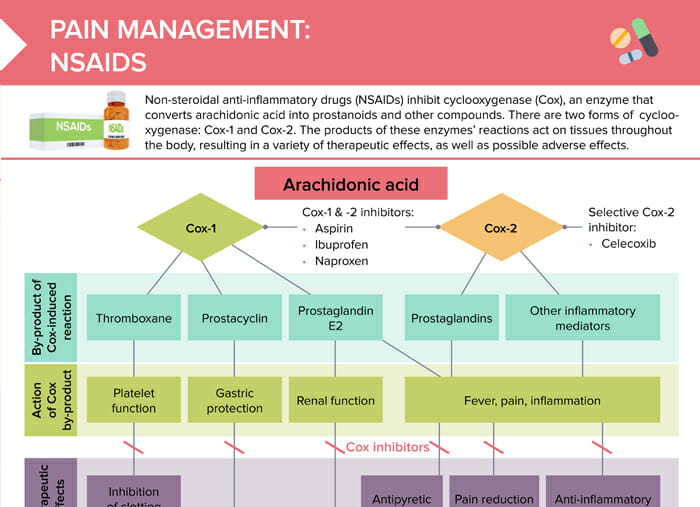What is arachidonic acid?
Arachidonic acid is a polyunsaturated omega-6 fatty acid found in the phospholipids of cell membranes, especially in the brain and muscles. Its main function involves cellular signaling.
What is the arachidonic acid pathway?
When a cell membrane is stimulated or damaged, phospholipase A2 releases arachidonic acid from membrane phospholipids. It can then be metabolized by three primary enzyme pathways, one of them being the cyclooxygenase (Cox) pathway:
- Cox 1: by-products of the Cox-1-induced reaction are
- Thromboxane → platelet function
- Prostacyclin → gastric protection
- Prostaglandin E2 → renal function
- Cox 2: by-products of the Cox-2-induced reaction are
- Prostaglandins → fever, pain, inflammation
- Other inflammatory mediators
What are Cox 1 and Cox 2?
Cox 1 and Cox 2 are enzymes that play key roles in the production of prostaglandins, which are involved in inflammation, pain, and other physiological processes. Cox 1 produces prostaglandins involved in protective actions, like maintaining the stomach lining and supporting kidney function. It’s considered a “housekeeping” enzyme because it’s always active and performing essential roles. Cox 2 produces prostaglandins that cause inflammation, pain, and fever. Its activity increases during inflammatory responses.
How do NSAIDs work?
NSAIDs (non-steroidal anti-inflammatory drugs) work by blocking the enzymes Cox 1 and Cox 2 in the body. This reduces the production of prostaglandins in the body, which promote inflammation, pain, and fever. NSAIDs therefore have anti-inflammatory, analgesic, and antipyretic effects.
Cox 1 inhibitors
Examples of Cox 1 inhibitors include aspirin, ibuprofen, and naproxen.
Even though most inhibit both enzymes, Cox 1 inhibitors typically have a stronger effect on Cox 1. Because COX-1 helps protect the stomach lining and support platelet function, its inhibition can lead to stomach ulcers and increased bleeding risk.
Cox 2 inhibitors
Cox 2 inhibitors specifically target and inhibit the Cox 2 enzyme. While this reduces the risk of the stomach-related side effects associated with Cox 1 inhibitors, some Cox 2 inhibitors have been associated with an increased risk of cardiovascular events.
A well-known example of a Cox 2 inhibitor is celecoxib.
Nursing considerations for NSAIDs
- Carefully review clients’ medical history and medication list for possible contraindications.
- Be alert to allergy history: avoid all NSAIDs in clients with allergy to any medication in the class.
- Educate clients regarding possible adverse effects of NSAIDs and signs/symptoms to report.
- Monitor BUN/creatinine and creatinine clearance carefully in clients at risk of renal compromise.
- Advise clients to discontinue NSAID use at least one week before scheduled surgery.
- Use teach–back to verify understanding.
Adverse effects of NSAIDs
Cox-1-inhibitors impact the actions of Cox 1:
- Platelet function:
- Therapeutic effect: inhibition of clotting
- Adverse effect: excessive bleeding
- Gastric protection:
- Adverse effects: GI upset, GI bleeding, peptic ulcers
- Renal function:
- Adverse effects: impaired renal function, hypertension
Cox-2-inhibitors impact the actions of Cox 2, namely production fever, pain, and inflammation, which does not directly result in any adverse effects.
